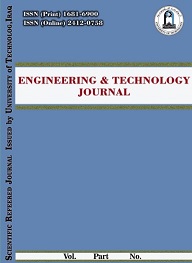Abstract
This work includes the digital image processing (image enhancement and
the digital classification techniques) using ERDAS, ver.,8.7, package for Landsat 7
(ETM+), 3-visible bands with resolution (14.25m), acquired in March 2004 .
The field investigation includes GPS device (Global Position System) to
determine the coordinates of soil sample location , which coincides with the
reports of the laboratory tests (chemical tests), which include organic matter, total
dissolved solid, sulphate, and electrical conductivity, due to the effectiveness of
these chemical properties on the spectral response of soil, and spectral
measurements by using radiometer instrument.
The main results of this study, by using GIS techniques depends on remote
sensing data, using ArcView software ver.3.3, a geographical database and
information about layers of soil of the overall studied area have been registered and
constructed digitally to represent the geotechnical soil characteristics in associated
files, and produce digital soil map. It is considered the preferable technique to
represent the ground truth regarding the characteristics of soil, in comparison with
the traditional method, because they are easy to produce, use, store and update, in
addition they save in efforts, time and cost.
the digital classification techniques) using ERDAS, ver.,8.7, package for Landsat 7
(ETM+), 3-visible bands with resolution (14.25m), acquired in March 2004 .
The field investigation includes GPS device (Global Position System) to
determine the coordinates of soil sample location , which coincides with the
reports of the laboratory tests (chemical tests), which include organic matter, total
dissolved solid, sulphate, and electrical conductivity, due to the effectiveness of
these chemical properties on the spectral response of soil, and spectral
measurements by using radiometer instrument.
The main results of this study, by using GIS techniques depends on remote
sensing data, using ArcView software ver.3.3, a geographical database and
information about layers of soil of the overall studied area have been registered and
constructed digitally to represent the geotechnical soil characteristics in associated
files, and produce digital soil map. It is considered the preferable technique to
represent the ground truth regarding the characteristics of soil, in comparison with
the traditional method, because they are easy to produce, use, store and update, in
addition they save in efforts, time and cost.
